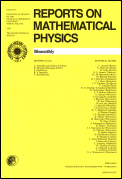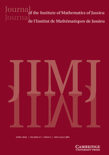
RUSSIAN JOURNAL OF MATHEMATICAL PHYSICS
Scope & Guideline
Fostering Dialogue in the World of Physics and Mathematics
Introduction
Aims and Scopes
- Mathematical Analysis and Asymptotics:
The journal extensively covers mathematical analysis and asymptotic methods, particularly in the context of differential equations, spectral theory, and wave propagation. This includes the study of asymptotic behavior of solutions to complex problems across various mathematical frameworks. - Quantum Mechanics and Operator Theory:
Research related to quantum mechanics, particularly operator theory, is a significant focus. This includes the study of quantum operators, spectral analysis, and the mathematical foundations of quantum theory, which are crucial for understanding underlying physical phenomena. - Fluid Dynamics and Nonlinear Systems:
The journal publishes works on fluid dynamics, particularly nonlinear systems, highlighting mathematical models that describe complex fluid behaviors, including wave interactions and boundary layer theory. - Lie Groups and Algebraic Structures:
A consistent theme involves the exploration of Lie groups and their applications in mathematical physics. This includes studies on representations, automorphisms, and the algebraic structures that underpin various physical theories. - Nonlinear Partial Differential Equations (PDEs):
The journal features research on nonlinear PDEs, focusing on their solutions, qualitative properties, and applications in physical models, which are essential for advancing theoretical physics. - Statistical Mechanics and Quantum Field Theory:
Papers related to statistical mechanics and quantum field theory are also prevalent, exploring the mathematical underpinnings of these fields and their implications in modern physics.
Trending and Emerging
- Semiclassical Analysis and Quantum Mechanics:
There is a notable increase in research related to semiclassical analysis, particularly its applications in quantum mechanics. This trend highlights the importance of understanding quantum systems through semiclassical methods, which are becoming increasingly relevant in modern physics. - Nonlinear Dynamics and Complex Systems:
Emerging themes in nonlinear dynamics and complex systems are gaining traction. This reflects a broader interest in understanding chaotic behaviors and complex interactions within physical systems, which are crucial for fields such as fluid dynamics and statistical mechanics. - Applications of Algebraic Structures in Physics:
The application of algebraic structures, particularly in the context of Lie groups and algebras, is trending upwards. This indicates a growing recognition of the importance of algebraic methods in solving physical problems and understanding symmetries in physics. - Mathematical Methods in Statistical Physics:
Research focusing on mathematical methods in statistical physics is on the rise. This includes advanced statistical techniques and their applications in understanding phase transitions and critical phenomena, reflecting a trend towards integrating mathematical rigor with physical insights. - Computational Approaches and Numerical Methods:
There is an increasing interest in computational methods and numerical approaches to solve complex mathematical problems in physics. This trend signifies a shift towards utilizing computational power to address problems that are analytically intractable.
Declining or Waning
- Classical Mechanics and Simple Systems:
Research focusing on classical mechanics and simple dynamical systems appears to be declining. The shift towards more complex, nonlinear systems may have contributed to this trend, as researchers seek to address more intricate physical phenomena. - Purely Theoretical Constructs without Applications:
There seems to be a waning interest in papers that focus solely on theoretical constructs without practical applications to real-world problems. Current trends favor research that bridges theory with application, particularly in interdisciplinary contexts. - Elementary Differential Equations:
Themes revolving around elementary differential equations have become less prominent, possibly due to the increasing complexity and abstraction of problems being addressed in the field. Researchers are more inclined to explore advanced and specialized equations.
Similar Journals

REPORTS ON MATHEMATICAL PHYSICS
Decoding the Language of the Universe through MathREPORTS ON MATHEMATICAL PHYSICS is a distinguished journal published by PERGAMON-ELSEVIER SCIENCE LTD, focusing on the intricate interplay between mathematics and physics. Established in the United Kingdom, this journal has been contributing to the academic community since its inception, publishing significant research findings that explore the theoretical underpinnings of physical phenomena. With an ISSN of 0034-4877 and an E-ISSN of 1879-0674, the journal maintains a consistent publishing history, converging research from 1970 to 2024. It is currently ranked Q3 in both Mathematical Physics and Statistical and Nonlinear Physics categories, reflecting its commitment to maintaining a high standard of scholarly work. Although it lacks Open Access options, its targeted audience of researchers, professionals, and students will find invaluable insights into advanced mathematical methods, statistical applications, and innovative approaches in physics. With its esteemed reputation and critical role in the field, REPORTS ON MATHEMATICAL PHYSICS continues to be an essential resource for those seeking to deepen their understanding of mathematical applications in physical systems.

Journal of Mathematical Physics Analysis Geometry
Connecting Ideas, Inspiring DiscoveriesThe Journal of Mathematical Physics Analysis Geometry is a vital scholarly platform dedicated to the exploration and dissemination of research at the intersection of mathematical physics, analysis, and geometry. Published by the esteemed B Verkin Institute of Low Temperature Physics and Engineering of NAS Ukraine, this journal serves as a conduit for innovative ideas and new findings within these disciplines. Though currently classified in Q4 quartiles across its categories for 2023—Analysis, Geometry and Topology, and Mathematical Physics—it provides a unique opportunity for researchers to contribute to a growing field of study that remains crucial for advancements in both theoretical and applied mathematics. Since its inception in 2008, the journal has prioritized open discourse among academics, promoting accessibility to significant developments without the constraints of high publication fees. The Journal of Mathematical Physics Analysis Geometry invites researchers, professionals, and students alike to engage with its content and partake in the dialogue that shapes the future of mathematical inquiry.

ZEITSCHRIFT FUR ANALYSIS UND IHRE ANWENDUNGEN
Empowering Research through Rigorous Peer ReviewZEITSCHRIFT FUR ANALYSIS UND IHRE ANWENDUNGEN, published by the European Mathematical Society, stands as a vital resource in the fields of analysis and applied mathematics. With an ISSN of 0232-2064 and E-ISSN 1661-4534, this esteemed journal has been disseminating high-quality research since its inception in 1996, converging its efforts through 2024. Recognized within Q2 quartiles of both analysis and applied mathematics categories, it ranks #98 out of 193 in Mathematics _ Analysis and #379 out of 635 in Mathematics _ Applied Mathematics according to Scopus, affirming its significant impact within the academic community. Although not open access, the journal provides a platform for rigorous peer-reviewed articles that foster the interplay between theoretical insights and practical applications, catering to the needs of researchers, professionals, and students alike. With its editorial board comprised of leading experts, ZEITSCHRIFT FUR ANALYSIS UND IHRE ANWENDUNGEN continues to advance mathematical knowledge, making it an essential journal for those aiming to stay at the forefront of analysis and its applications.

Advances in Operator Theory
Exploring the Frontiers of Algebra and AnalysisAdvances in Operator Theory is a premier journal dedicated to the exploration of innovative and foundational research within the disciplines of Algebra and Number Theory, as well as Analysis. Published by SPRINGER BASEL AG, this journal provides a vital platform for the dissemination of high-quality research and theoretical advancements in the realm of operator theory. With a commendable impact factor and categorized in the Q3 quartile for both Algebra and Number Theory and Analysis in 2023, it holds significant standing in the Scopus rankings, substantiating its relevance in the mathematical community. The journal encourages open discussions and lively exchange of ideas among researchers, professionals, and students alike, fostering an environment conducive to scholarly growth and collaboration. Based in Iran at PICASSOPLATZ 4, BASEL 4052, SWITZERLAND, it has been actively publishing since 2016, making substantial contributions to its field through rigorous peer-reviewed articles. As an essential resource for anyone invested in the forefront of mathematical research, Advances in Operator Theory continues to illuminate complex topics and inspire future inquiries.

Journal of the Institute of Mathematics of Jussieu
Elevating the Standards of Mathematical ScholarshipJournal of the Institute of Mathematics of Jussieu, published by Cambridge University Press, is a leading academic journal that has established itself as a vital resource in the field of mathematics. With an impressive impact factor and a ranking in the top quartile (Q1) of miscellaneous mathematics, the journal serves as a platform for high-quality research from both established scholars and emerging researchers. Spanning from 2002 to 2024, the journal aims to foster collaboration and innovation in the mathematical community by publishing original research articles, reviews, and critical discussions on a wide range of mathematical topics. Although the journal does not offer open access, it remains widely accessible through various academic institutions and libraries, ensuring that critical advancements in mathematics are shared with a global audience. Located in the United Kingdom at the prestigious Cambridge campus, the journal reflects the rigorous standards of its publisher and the rich academic tradition of its home institution.

THEORETICAL AND MATHEMATICAL PHYSICS
Pioneering Insights in Nonlinear PhysicsTHEORETICAL AND MATHEMATICAL PHYSICS, published by MAIK NAUKA/INTERPERIODICA/SPRINGER, is a premier journal dedicated to advancing the fields of Mathematical Physics and Statistical and Nonlinear Physics. With an impressive history spanning from 1969 to 2024, this journal serves as a vital platform for researchers, professionals, and students eager to explore cutting-edge theoretical frameworks and mathematical models. Although it currently holds a Q3 ranking in both its categories as per the 2023 metrics and is positioned within the Scopus ranks reflecting its growing influence, the journal continually aims to enhance its impact within the academic community. The publication does not currently provide open-access options, underscoring its collector’s nature in the dissemination of valuable research findings. Submissions are welcomed from diverse areas of theoretical physics, providing a rich and collaborative environment for the exploration of complex phenomena and the development of innovative methodologies.

MONATSHEFTE FUR MATHEMATIK
Bridging Historical Contexts with Contemporary ChallengesMONATSHEFTE FUR MATHEMATIK, published by Springer Wien, stands as a pivotal academic journal in the field of mathematics, with its esteemed history tracing back to 1890. With an ISSN of 0026-9255 and an E-ISSN of 1436-5081, this journal encompasses a rich array of topics and contributions within the realm of mathematical research, catering to both historical and contemporary discourse. Although not an open access journal, it maintains a Q2 rank in the mathematical category as per the 2023 assessment, illustrating its significant impact and relevance, as evidenced by its Scopus ranking of #160/399, placing it at the 59th percentile within the general mathematics category. Published in Austria, MONATSHEFTE FUR MATHEMATIK provides a platform for researchers, professionals, and students to explore innovative mathematical theories and applications through its various converged years of contributions, from 1890 to 2024. This journal is an essential resource for anyone invested in advancing their understanding of mathematical concepts and fostering scholarly dialogue in the field.

Analysis and Mathematical Physics
Transforming Mathematical Theory into Practical SolutionsAnalysis and Mathematical Physics is a distinguished scholarly journal dedicated to advancing the fields of algebra, analysis, and mathematical physics. Published by Springer Basel AG, this journal serves as a pivotal platform for researchers and practitioners to disseminate innovative findings and theoretical advancements. With an impact factor that underscores its significance, it ranks in the Q1 category for Algebra and Number Theory and Q2 for both Analysis and Mathematical Physics as of 2023. The journal's robust standing is further reflected in its impressive Scopus rankings, placing it within the top 15% in Algebra and Number Theory and 32nd in Mathematical Physics. Notably, the journal fosters open dialogue across various mathematical disciplines, aiming to connect theory with practical applications. Through its thoughtful selection of rigorous research contributions, Analysis and Mathematical Physics remains an essential resource for academic scholars, industry professionals, and students striving to deepen their understanding and engage with complex mathematical concepts.

Communications in Analysis and Mechanics
Fostering groundbreaking insights in mathematics and engineering.Communications in Analysis and Mechanics is a pioneering journal published by the AMER INST MATHEMATICAL SCIENCES (AIMS), dedicated to advancing the fields of mathematics, engineering, and applied sciences. With its recent transition to Open Access in 2023, the journal aims to enhance the dissemination of high-quality research by fostering a collaborative environment for researchers, professionals, and students. Operating from the United States, this journal embraces a broad scope encompassing geometry, optimization, and mechanics, ensuring a comprehensive platform for innovation and critical discourse. Despite its nascent status, it features competitive Scopus rankings in various disciplines, notably achieving a percentile around 7th to 13th, indicative of its growing impact among peers. The editorial team is committed to publishing original research that addresses significant challenges and developments within the mathematical sciences, facilitating a vital exchange of ideas and methodologies.

NONLINEARITY
Exploring the Depths of Complex SystemsNONLINEARITY is a premier academic journal published by IOP Publishing Ltd, dedicated to advancing the field of complex systems through the lens of nonlinear science. Since its inception in 1988, the journal has established itself as a vital resource for researchers and professionals alike, offering a robust platform for disseminating high-quality research in areas such as applied mathematics, mathematical physics, and statistical and nonlinear physics. With an impressive Q1 ranking across multiple pertinent categories, including Applied Mathematics and Mathematical Physics, NONLINEARITY ranks among the top journals globally, making it essential reading for those seeking to deepen their understanding of nonlinear phenomena. Although it does not operate under an open-access model, its rich repository of rigorous articles significantly contributes to academia, fostering innovative thought and facilitating cutting-edge research. Located in the heart of the United Kingdom at TEMPLE CIRCUS, TEMPLE WAY, BRISTOL BS1 6BE, NONLINEARITY continues to be at the forefront of the scientific community, championing new discoveries and interdisciplinary dialogue within its dynamic scope.